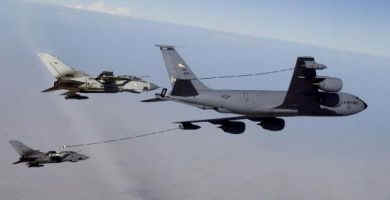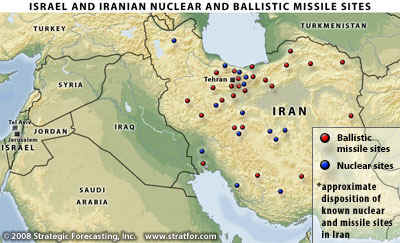Israel: A Handful of Aerial Tankers and
More Regional Sway
posted at LebanonWire
|

|
|
British GR4 Tornadoes approach the drogues of a KC-135, with
refueling probes extendedSummary
|
Summary
Israeli Defense Minister Ehud Barak may have asked to purchase — and
then been denied — a number of Boeing KC-767 aerial refueling tankers.
The report, aired by Israeli Channel 10 News on Aug. 21, may not be
reliable. But it does present an opportunity for Stratfor to examine
the geopolitical significance of Israel’s tanker fleet in light of
regional tensions and ongoing negotiations between Washington and
Tehran.
Analysis
Washington may have turned down a request by Israeli Defense Minister
Ehud Barak to purchase an unspecified number of Boeing aerial refueling
tankers, according to an Aug. 21 report by Israeli Channel 10 News.
Though questions about the veracity of the report have already begun to
emerge, it does shed light on Israel’s aerial refueling capability,
which is a significant issue in the region.
Israel is already known to
possess an aerial refueling capability, though some details are
disputed. The Israeli air force (IAF) does in fact operate around five
KC-130H tankers, a variant of the venerable C-130 Hercules. Less clear
is the status of as many as five IAF Boeing 707s, the airframe of the
long-serving U.S. Air Force KC-135 tanker. Several are known to be
operational. Some reports suggest that all five of these aircraft are
not only operational but also have been recently upgraded. We consider
it highly likely that this is the case, and that Israel already
possesses a significant aerial refueling capability.
Nevertheless, the IAF would
probably be extremely stretched in terms of these assets to attempt a
bombing campaign against Iran. Even if a direct route over Iraq were
chosen (this is, of course, problematic for a number of reasons), which
could allow some of the IAF’s newest strike aircraft like the F-15I
Ra’am and F-16I Sufa to operate without refueling, the operation would
still put a burden on the tanker fleet in sustaining support aircraft
and combat search and rescue assets.
 An important distinction here is the difference between
the flying boom and more traditional hose-and-drogue methods (most
aircraft are equipped to refuel one way or the other). The former is
mounted on both the KC-135 and KC-767 and is able to deliver fuel
faster and at a much higher rate — so high that many aircraft are
unable to receive fuel at full-boom capacity. The latter can be fitted
to both the KC-135 and KC-767 in pods mounted on the wings and is the
only method the KC-130 uses. It was the first to be developed and,
though less technically complex, is significantly slower. This goes to
the heart of the efficiency of an aerial refueling operation. The
faster aircraft can cycle through and top off, the less fuel they burn
as the whole formation rotates through. More tanker aircraft also
facilitates this efficiency. An important distinction here is the difference between
the flying boom and more traditional hose-and-drogue methods (most
aircraft are equipped to refuel one way or the other). The former is
mounted on both the KC-135 and KC-767 and is able to deliver fuel
faster and at a much higher rate — so high that many aircraft are
unable to receive fuel at full-boom capacity. The latter can be fitted
to both the KC-135 and KC-767 in pods mounted on the wings and is the
only method the KC-130 uses. It was the first to be developed and,
though less technically complex, is significantly slower. This goes to
the heart of the efficiency of an aerial refueling operation. The
faster aircraft can cycle through and top off, the less fuel they burn
as the whole formation rotates through. More tanker aircraft also
facilitates this efficiency.
Even a handful of Boeing
KC-767 tankers would dramatically increase both the IAF’s number of
boom-equipped tankers and its overall capacity to sustain a major air
campaign at longer ranges (the scale of the requested acquisition was
not specified, but it would unlikely exceed a half dozen or so). This
would give Israel more options in terms of both vectors of attack and
the size of the strike package it can sustain. In other words, it would
significantly increase Israel’s capacity for independent military
action against Iran.
This is something neither
Washington nor Tehran are interested in right now. Israel has done what
it can to convince Iran that it is seriously considering a strike — and
is fully prepared to undertake it. While Tehran knows it is some
distance from Israel and that some of its key nuclear facilities are
deeply buried and hardened against airstrikes, it is also exceedingly
wary following the Sept. 6, 2007, IAF raid in Syria that completely
abrogated Damascus’ air-defense network.
In this case, though,
Washington holds the cards. Despite what would surely be intense
pressure from Boeing to allow the sale, the United States cannot at the
moment sell tools to Israel that may be seen as a deal-breaker in its
negotiations with Iran, which is key to the U.S. disentanglement from
Iraq. It is unlikely that delivery would take place in the next year,
leaving adequate room for the Bush administration to attempt to
solidify a deal with Tehran.
But this hesitance extends
beyond just the current dynamic with Tehran. The United States and
Israel do not always see eye-to-eye in terms of geopolitical necessity
(take the 1956 Suez Crisis, for example). Washington wants Israel to be
the predominant military power in the region, and it continues to share
the very latest in ballistic missile defense technology with the Jewish
state. But the United States does not want Israel to have the
capability to start trouble all on its own at even greater distances.
An expanded aerial refueling capability would dramatically increase
Israel’s military capability to do just that.
This article
is published at Lebanonwire
by agreement with www.stratfor.com,
the
world's leading private intelligence provider. For any questions or
comments on this article please write to analysis@stratfor.com
|